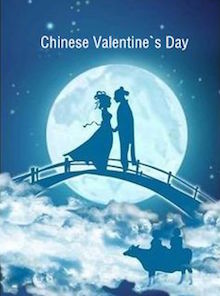I think I’ve mentioned before, that China has a number of “Valentine’s Days.” In the United States, we celebrate Valentine’s Day on the 14th of February. And fairly recently, 2/14 has become a popular celebration in China — imported from the West. It’s particularly popular among the younger generation — much like in the West, Chinese couples spend time together by going to the movies or for romantic dinners.
But today, August 4, 2020, is also Chinese Valentine’s Day — In China, it’s known as the Qi Xi Festival, often called the Qixi Festival. It is celebrated on July 7th (7/7) on the Lunar calendar, which means the date on our calendar usually falls in the month of August — this year, it’s today, August 4th.
The Qisi Festival comes from the romantic tale of two lovers who can only come together once a year, which is why it’s celebrated on this day.
If you’re researching this particular Chinese Valentine’s Day, you may find it listed under different names, such as the Double Seven Festival, or the Daughter’s Festival. It’s sometimes referred to as the Double Seven Festival because in literal terms, the word “qixi” means “evening of sevens” as it represents the seventh day of the seventh month per the Chinese lunar calendar.
Since this is a Chinese Valentine’s Day, people celebrate the occasion as a day of love by buying presents for their spouses or romantic partners… however, the Chinese like to observe the day by following various local customs.

The Qixi Festival has its roots in ancient Chinese folklore. The legend goes that Zhinü, a weaving girl from Heaven, descended to Earth and fell in love with a mortal named Niulang. They married each other without the knowledge of Zhinü’s mother, the Goddess of Heaven. Zhinü bore Niulang two beautiful children and lived happily until her mother learned of her transgressions, went into a rage, and sent soldiers to retrieve her. Zhinü went back to Heaven.
Sometime later, Niulang tried to rescue his wife, but the Goddess of Heaven took out her hairpin and created a massive river, thinking she had separated the lovers forever. However, Niulang and Zhinü’s love was stronger than she thought. It moved the magpies so much that they flew up to Heaven to form a bridge over the river.
Seeing the love between her child and a mortal man, the Goddess of Heaven allowed the lovers to meet on the Magpie bridge on the seventh day of the seventh lunar month every year — and that’s how the Qixi Festival came into being.
According to several Chinese beliefs, the river represents the Milky Way, while Zhinü and Niulang represent the constellations of Vega and Altair. The festival was first recognized as a formal occasion during the Han Dynasty, over 2,600 years ago.
Although it sounds romantic, the festival was not initially intended for lovers but for young girls to worship the weaving fairy and hone their skills at handcraft.
So if you’re like me, and hate the crowds at restaurants on February 14th, this Chinese Valentine’s Day may be your cup of tea. We usually get a quizzical look when we tell the waiter that we’re celebrating Valentine’s Day, but we always get the same look when we show up the day before, or after our “traditional” Valentine’s day, too.
Happy Chinese Valentine’s Day.
